Related Research Articles

The War of the Polish Succession was a major European conflict sparked by a Polish civil war over the succession to Augustus II of Poland, which the other European powers widened in pursuit of their own national interests. France and Spain, the two Bourbon powers, attempted to test the power of the Austrian Habsburgs in Western Europe, as did the Kingdom of Prussia, whilst Saxony and Russia mobilized to support the eventual victor. The fighting in Poland resulted in the accession of Augustus III, who in addition to Russia and Saxony, was politically supported by the Habsburgs.
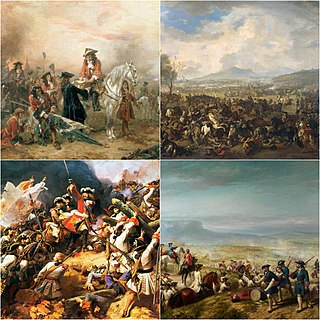
The War of the Spanish Succession was a European great power conflict fought between 1701 and 1714. The immediate cause was the death of the childless Charles II of Spain in November 1700, which led to a struggle for control of the Spanish Empire. His nominated heir was Philip of Anjou, a grandson of Louis XIV of France, whose main backers were France and most of Spain. His rival, Archduke Charles of Austria, was supported by the Grand Alliance, whose primary members included the Holy Roman Empire, the Dutch Republic, and Great Britain. Significant related conflicts include the 1700 to 1721 Great Northern War, and Queen Anne's War in North America.

Charles Emmanuel I, known as the Great, was the Duke of Savoy and ruler of the Savoyard states from 30 August 1580 until his death almost 50 years later in 1630. He was nicknamed Testa d'feu for his rashness and military aggression.

Victor Amadeus I was the Duke of Savoy and ruler of the Savoyard states from 26 July 1630 until his death in 1637. He was also known as the Lion of Susa.
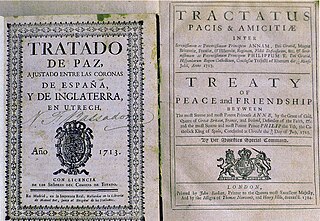
The Peace of Utrecht was a series of peace treaties signed by the belligerents in the War of the Spanish Succession, in the Dutch city of Utrecht between April 1713 and February 1715. The war involved three contenders for the vacant throne of Spain, and involved much of Europe for over a decade. The main action saw France as the defender of Spain against a multinational coalition. The war was very expensive and bloody, and finally stalemated. Essentially, the treaties allowed Philip V to keep the Spanish throne in return for permanently renouncing his claim to the French throne, along with other necessary guarantees that would ensure that France and Spain should not merge, thus preserving the balance of power in Europe.

The Peace of Ryswick, or Rijswijk, was a series of treaties signed in the Dutch city of Rijswijk between 20 September and 30 October 1697. They ended the 1688 to 1697 Nine Years' War between France and the Grand Alliance, which included the Dutch Republic and the Holy Roman Empire.

The Grand Alliance, sometimes referred to as the League of Augsburg, was formed on 20 December 1689. Signed by William III on behalf of the Dutch Republic and England, and Emperor Leopold I for the Habsburg Monarchy, its primary purpose was to oppose the expansionist policies of Louis XIV of France.
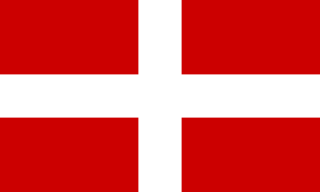
The Duchy of Savoy was a territorial entity of the Savoyard state that existed from 1416 until 1860 and was a possession of the House of Savoy.
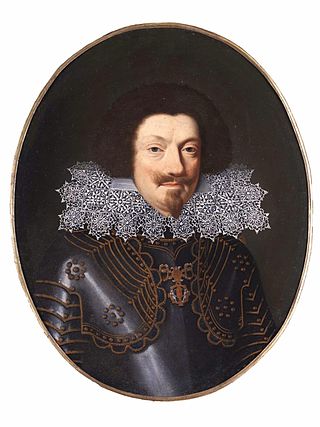
The War of the Mantuan Succession (1628–1631) was a conflict related to the Thirty Years' War and was caused by the death in December 1627 of Vincenzo II, the last male heir in the direct line of the House of Gonzaga and the ruler of the Duchies of Mantua and Montferrat. Those territories were key to control of the Spanish Road, an overland route that allowed Habsburg Spain to move recruits and supplies from Italy to their army in Flanders. The result was a proxy war between France, which supported the French-born Duke of Nevers, and Spain, which backed a distant cousin, the Duke of Guastalla.

The Italian War of 1551–1559 began when Henry II of France declared war against Holy Roman Emperor Charles V with the intent of recapturing parts of Italy and ensuring French, rather than Habsburg, domination of European affairs. The war ended following the signing of the Treaty of Cateau-Cambrésis between the monarchs of Spain, England and France in 1559. Historians have emphasized the importance of gunpowder technology, new styles of fortification to resist cannon fire, and the increased professionalization of the soldiers.

The Italian War of 1542–1546 was a conflict late in the Italian Wars, pitting Francis I of France and Suleiman I of the Ottoman Empire against the Holy Roman Emperor Charles V and Henry VIII of England. The course of the war saw extensive fighting in Italy, France, and the Low Countries, as well as attempted invasions of Spain and England. The conflict was inconclusive and ruinously expensive for the major participants.
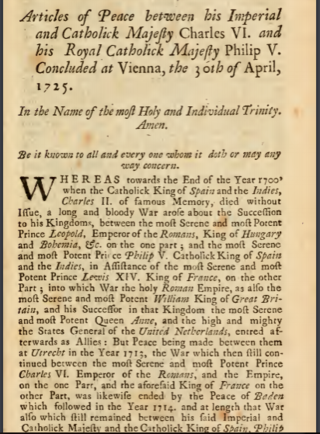
The Peace of Vienna was a series of four treaties signed between 30 April 1725 and 5 November 1725 by the Habsburg monarchy, the Holy Roman Empire, and Bourbon Spain; the Russian Empire later joined the newly-found alliance in 1726. The signing of this treaty marks the founding of the Austro-Spanish Alliance and led the Fourth Anglo-Spanish War (1727-1729). This new alliance thereby removed Austria from the Quadruple Alliance. In addition to a formation of the new partnership, the Habsburgs relinquished all formal claims to the Spanish throne, while the Spanish removed their claims in the Southern Netherlands, and a number of other territories.

The siege of Cuneo was fought on 28 June 1691 during Nine Years' War in Piedmont-Savoy, modern-day northern Italy. The siege was part of French King Louis XIV’s campaign against Victor Amadeus, the Duke of Savoy, who had sided with the Grand Alliance the previous year. The siege was an attempt to gain a foothold on the Piedmont Plain, thus ensuring Marshal Catinat's army could winter east of the Alps. Yet due to the incompetence of the two French commanders – and a timely arrival of Imperial reinforcements – the siege proved a disaster, resulting in the loss of between 700 and 800 men. Although French forces had taken Nice in the west, and Montmélian in the north, Catinat's small, ill-equipped army was forced onto the defensive. Louis XIV subsequently offered Amadeus generous peace terms but the Duke, who had by now received substantial Imperial reinforcements from the Empire, considered himself strong enough to continue hostilities.

The 1720 Treaty of The Hague was signed on 17 February 1720 between Spain and the Quadruple Alliance, established by the 1718 Treaty of London. Its members included Britain, France, the Dutch Republic and Austria.
The Treaty of Brussol was signed on 10 April 1610 in Bruzolo between Charles Emmanuel I, Duke of Savoy, and Henry IV of France, inside the Castle of Bruzolo,. Based on the terms of the accord, both signatories agreed to combine their forces in order to remove the Spanish from Italy. The agreement also dictated that the Duke of Mantua exchange the province of Casale Monferrato for the province of Cremona. Also, the territories of Montferrat and Milan would be united under the control of Savoy. Under the treaty, Victor Emmanuel would be restored to the throne of Lombardy. Also, Henry IV would have his daughter marry Prince Victor Amadeus I and that the King of France, the Republic of Venice, and the Pope guarantee the Duke of Savoy the title of King of Lombardy. However, this accord was never realized since Henry IV was assassinated by Ravaillac in May 1610. Marie de' Medici, just crowned queen, overturned the treaty. Even though Henry's death ended the treaty, Charles Emmanuel seized Montferrat from the Spanish in 1613, which led to a war that lasted until 1617.
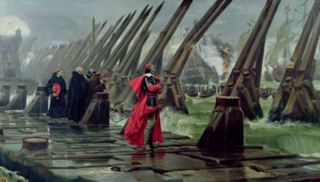
The Anglo-French War was a military conflict fought between the Kingdom of France and the Kingdom of England between 1627 and 1629. It mainly involved actions at sea. The centrepiece of the conflict was the siege of La Rochelle (1627–28), in which the English Crown supported the French Huguenots in their fight against the French royal forces of Louis XIII of France. La Rochelle had become the stronghold of the French Huguenots, under its own governance. It was the centre of Huguenot seapower and the strongest centre of resistance against the central government. The English also launched a campaign against France's new colony in North America which led to the capture of Quebec.
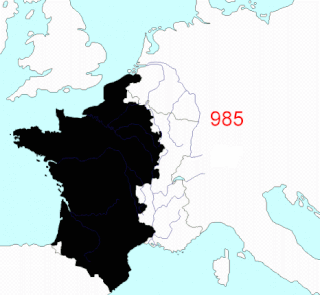
This article describes the process by which the territorial extent of metropolitan France came to be as it is since 1947. The territory of the French state is spread throughout the world. Metropolitan France is that part which is in Europe.
The Treaty of Monçon or Treaty of Monzón was signed on 5 March 1626 by Cardinal Richelieu, the chief minister of Louis XIII and Gaspar de Guzmán, Count-Duke of Olivares, the chief minister of Philip IV of Spain, at Monçon in Aragon. It was signed in the aftermath of the French capture of Valtellina from papal troops, ending the Valtellina War and also concluded the First Genoese-Savoyard War.

The Treaty of Turin, signed on 29 August 1696 by the French King and the Duchy of Savoy, ended the latter's involvement in the Nine Years' War.

The Treaty of Cateau-Cambrésis or Peace of Cateau-Cambrésis in April 1559 ended the Italian War of 1551–1559, the last of the Italian Wars (1494–1559). It consisted of several separate treaties, the main two signed on 2 April by Elizabeth I of England and Henry II of France, and on 3 April between Henry and Philip II of Spain. Although he was not a signatory, the agreements were approved by Emperor Ferdinand I, since many of the territorial exchanges concerned states that were part of the Holy Roman Empire.
References
This article includes a list of references, related reading, or external links, but its sources remain unclear because it lacks inline citations .(September 2016) |
- The life of Cardinal Richelieu (treaty with Savoy)
- European treaties bearing on the history of the United States and its Dependencies (treaty with England)